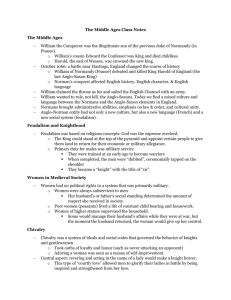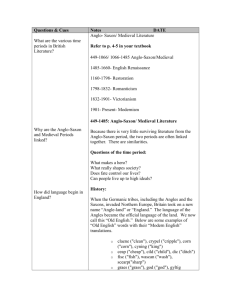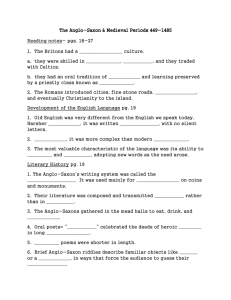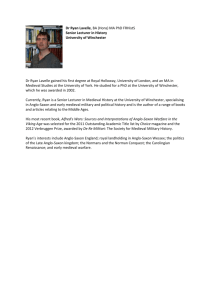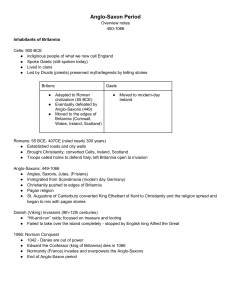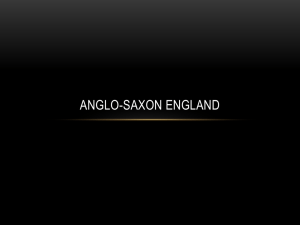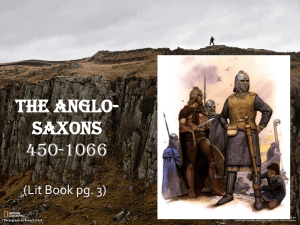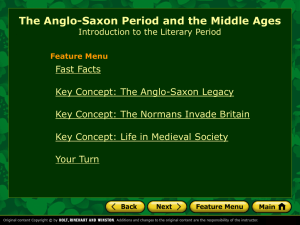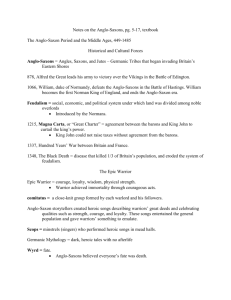The Anglo-Saxon and Medieval Periods 449
advertisement
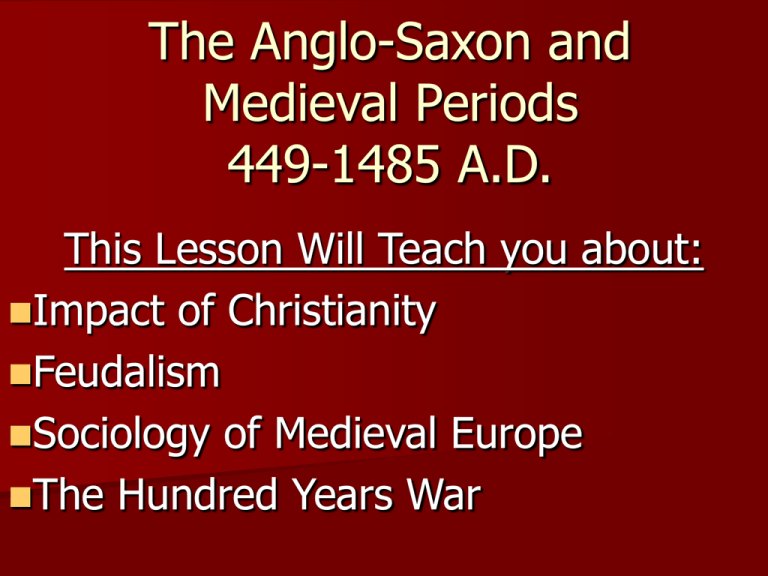
The Anglo-Saxon and Medieval Periods 449-1485 A.D. This Lesson Will Teach you about: Impact of Christianity Feudalism Sociology of Medieval Europe The Hundred Years War The Anglo-Saxon Period 449-1066 Britannia (Great Britain) had been abandoned by the Roman Empire—the Roman Army fled to protect the city of Rome from invasion during the early part of the 5th century. The Anglo-Saxon Period 449-1066 Without protection, the islands were invaded by Germanic peoples beginning in the 5th century (449A.D.) Primary Tribes: –Angles –Saxons The Anglo-Saxon Period 449-1066 The “Britons” were led by a Christian commander named Arthur. Unfortunately, they were unable to protect Britannia German tribes took over southern & central parts Brittania forcing the native people (Celtics) to the north and west. Celtic culture & pagan religions all but disappeared. Interesting Fact: The Celtics reemerged in Boston, Massachusetts (USA) in 1946 The Anglo-Saxon Period 449-1066 Because the Angles Tribe was the predominant tribe in southern Britannia at the time, the new settlement became known as “Angle-land,” or England (modern pronunciation). Although the Angles were the dominant tribe, scholars still refer to this period as the Anglo-Saxon Period. Lives of the Anglo-Saxons Changed Over Time In the beginning… – Seafaring people – Short – Bleak – Violent – Pagan Religion After Christianity… – Strong belief in the “Wyrd” (fate) – Admired warriors whose “wyrd” was to prevail in battle – Less violent – More secure – More civilized – agriculturalists Growth of Christianity Anglo-Saxons began adopting Christianity during late 6th century. Gaels (native tribe) spread Christianity to Angles. Augustine establishes first monastery at Canterbury in 597A.D. Within the next century, most people became Christian. Final Invasion of England Dispute as to who would succeed the throne in 1066. William, Duke of Normandy, attacks Harold in the “Battle of Hastings” on Christmas day 1066 A.D. William takes over throne and is renamed William “the Conqueror.” Medieval Period begins. The Medieval Period 1066-1485 Introduction of the Normans (French: “north men”) to the region brought about a lot of change. Brought over “French practices.” Ushers in new regime—beginning of the Medieval Period. Feudal System of Medieval Period Definition—a political and economic system in which the hierarchy was based on the king owning all the land in the kingdom and subdividing it. 25%--The King lived on and owned (castles) 25%--Dedicated to the Church (cathedrals) 50%--Gets further subdivided to loyal nobles— mostly Norman barons (manors). – Normans supplied king with warriors on horseback called knechts <Old Eng: servant> Feudal System Hierarchy King—owned all the land in the kingdom Nobles/Barons—”rented” subdivided land by providing knights and allegiance to the king. Knights—warriors for protection & allegiance to the Nobles and Barons. Serfs—the Anglo-Saxons that were conquered by the Normans became peasants bound to the land the could not own. Creation of new Judicial System Henry II takes over and enacts new system Royal Courts throughout the country System of Juries Formation of English Common Law – based on old practices, tradition, and values. Discussion Question: Why is the idea of a judicial system such a revolutionary concept compared to the feudal system? Compare Henry’s system of government to modern democracies. What are some similarities? Chivalry Wife of Henry II introduced ideals of chivalry she brought with her from France when she took over as Queen of England. Chivalry—code of honor intended to govern knightly behavior. – Honor and protection of women, children, and most importantly: CHRISTIANITY! – Go on Holy Quests (Crusades) in order to spread and maintain Christian principles and teachings. Crusades Richard I (“Richard the LionHearted”) spent much of 10year reign fighting Crusades in France to protect Christianity. Brother John ruled during his absence and was dubbed a tyrant – Subject of “Robin Hood” stories Treasury had become bankrupt from wars. “Magna Carta” signed in 1215 giving more power to barons. – Step toward modern democracy. End of Feudalism Signing of Magna Carta in 1215 A.D. brought about socioeconomic change. Commoners power increased as trade increased with Western Europe and Asia. Merchants & Craftspeople formed Guilds. – Set up rules for trading/economy – Moderated prices in the market – Wealth shifted from land ownership to mercantilism and trade. Universities blossomed (Oxford) The Hundred Years War 1337-1453 On-and-Off War Between England & France. “The Plague”—Black Death killed 30-40% of England’s population Domestic “War of the Roses” to seat new King. “Red Rose” wins out and seats as Henry VII. Seating of new King ends “Middle Ages” (Medieval Period) in England.
